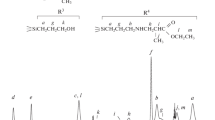Abstract
NMR and Raman spectroscopy studies were performed for different 3-aminopropyl(trimethoxy)- and 3-glycidoxypropyl(trimethoxy)silane based sol-gel systems containing different ketones. Exceptionally stable imine products were obtained depending on a reaction system at alkaline pH conditions and in the presence of water. These imine formation reactions were carried out without further catalyst. In addition, effect of water for the epoxy ring opening process was demonstrated, as well as the effect of solvents for the reaction path was confirmed.

The reaction between 3-aminopropyl(trimethoxy)- and 3-glycidoxypropyl(trimethoxy)silane needs additional catalyst to proceed fast or the reaction between the organic parts remains very slow. In case of isopropyl alcohol as the solvent, the result is the same. Water catalyses the organic and hydrolysation/condensation reactions. Ketones, like acetone initiates stable imine formation and water as a by-product methoxy group hydrolysation, but the epoxy groups remains unchanged after long period
Highlights
-
Stable organosiloxane based imines were synthesised in the presence of water as a by-product and in a very alkaline conditions (pH ≥ 12).
-
Synthesised and characterised amine/epoxy/ketone – sol-gel one-pot systems proved that ketones and amines form imines, as was expected, and these imines showed to be very stable in aqueous solutions and no drying agents, extraction or precursors having aromatic substituents were used during the syntheses.












Similar content being viewed by others
References
Schiff H (1864–1865) Ann Chem Pharm 131:118–124
Belowich ME, Stoddart JF (2012) Chem Soc Rev 41:2003–2024
Streitwieser A, Heathcock CH, Kosower EM (1992) Introduction to organic chemistry, 4th ed. Macmillan Publishing Company: New York
Clayden J, Greeves N, Warren S, Wothers P (2001) Organic chemistry, 1st ed. Oxford University Press: Oxford
Pine SH, Hendrickson JB, Cram DJ, Hammond GS (1981) Organic chemistry, 4th ed. McGraw-Hill Inc.: New York
Shechter L, Wynstra J, Kurkjy RP (1956) Ind Eng Chem 48(1):94–97
Horne WH, Shriner RL (1932) J Am Chem Soc 54:2925–2930
Smith IT (1961) Polym (Guildf) 2:95–108
Suzuki K, Matsu-Ura N, Horii H, Sugita Y, Sanda F, Endo T (2002) J Appl Polym Sci 83(8):1744–1749
Okuhira H, Kii T, Ochi M, Takeyama H (2004) J Adhes Sci Tech 18(2):205–211
Simion A, Simion C, Kanda T, Nagashima S, Mitoma Y, Yamada T, Mimura K, Tashiro M (2001) J Chem Soc Perkin Trans 1:2071–2078
Godoy-Alcántar C, Yatsimirsky AK, Lehn J-M (2005) J Phys Org Chem 18:979–985
Keränen M, Gnyba M, Raerinne P, Kololuoma T, Maaninen A, Rantala JT (2004) J Sol-Gel Sci Tech 31:369–372
Gnyba M, Keränen M, Kozanecki M, Bogdanowicz R, Kosmowski BB, Wroczyński P (2002) Opto-Electron Rev 10(2):137–143
Lee M, Kim H, Rhee H, Choo (2003) J Bull Korean Chem Soc 24(2):205–208
Lin-Vien D, Colthrup NB, Fateley WG, Grasselli JG (1991) The handbook of infrared and Raman characteristic frequencies of organic molecules. Academic Press Inc., San Diego
Acknowledgements
Research presented here were partially supported by the VTT – Technical Research Center of Finland and by the Gdańsk University of Technology (DS project of the Faculty of ETI). This article is also based upon work from COST Action “Raman-based applications for clinical diagnostics – Raman4Clinics” (BM 1401), supported by COST (European Cooperation in Science and Technology).
Author information
Authors and Affiliations
Corresponding author
Ethics declarations
Conflict of interest
The authors declare that they have no conflict of interest.
Rights and permissions
About this article
Cite this article
Keränen, M., Maaninen, A., Gnyba, M. et al. Spectroscopic studies of a ring opening process between epoxy- and aminosilanes and imine formation reactions in aqueous solutions. J Sol-Gel Sci Technol 87, 725–733 (2018). https://doi.org/10.1007/s10971-018-4758-z
Received:
Accepted:
Published:
Issue Date:
DOI: https://doi.org/10.1007/s10971-018-4758-z



